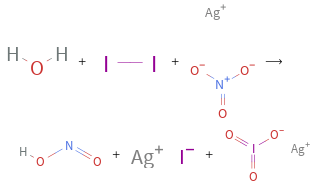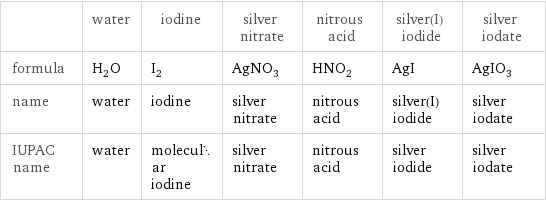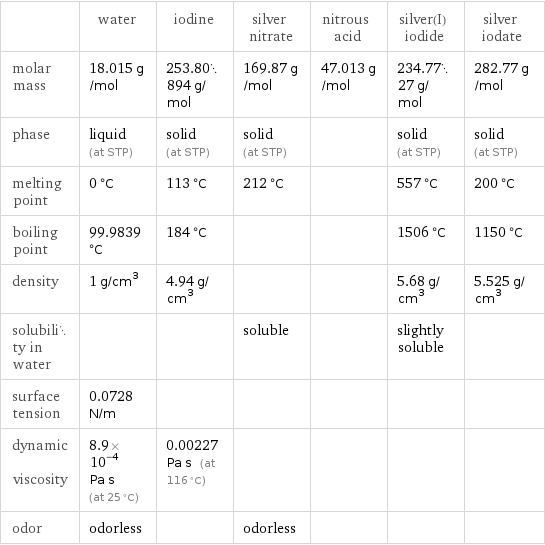Input interpretation

H_2O water + I_2 iodine + AgNO_3 silver nitrate ⟶ HNO_2 nitrous acid + AgI silver(I) iodide + AgIO_3 silver iodate
Balanced equation

Balance the chemical equation algebraically: H_2O + I_2 + AgNO_3 ⟶ HNO_2 + AgI + AgIO_3 Add stoichiometric coefficients, c_i, to the reactants and products: c_1 H_2O + c_2 I_2 + c_3 AgNO_3 ⟶ c_4 HNO_2 + c_5 AgI + c_6 AgIO_3 Set the number of atoms in the reactants equal to the number of atoms in the products for H, O, I, Ag and N: H: | 2 c_1 = c_4 O: | c_1 + 3 c_3 = 2 c_4 + 3 c_6 I: | 2 c_2 = c_5 + c_6 Ag: | c_3 = c_5 + c_6 N: | c_3 = c_4 Since the coefficients are relative quantities and underdetermined, choose a coefficient to set arbitrarily. To keep the coefficients small, the arbitrary value is ordinarily one. For instance, set c_1 = 1 and solve the system of equations for the remaining coefficients: c_1 = 1 c_2 = 1 c_3 = 2 c_4 = 2 c_5 = 1 c_6 = 1 Substitute the coefficients into the chemical reaction to obtain the balanced equation: Answer: | | H_2O + I_2 + 2 AgNO_3 ⟶ 2 HNO_2 + AgI + AgIO_3
Structures

+ + ⟶ + +
Names

water + iodine + silver nitrate ⟶ nitrous acid + silver(I) iodide + silver iodate
Equilibrium constant
![Construct the equilibrium constant, K, expression for: H_2O + I_2 + AgNO_3 ⟶ HNO_2 + AgI + AgIO_3 Plan: • Balance the chemical equation. • Determine the stoichiometric numbers. • Assemble the activity expression for each chemical species. • Use the activity expressions to build the equilibrium constant expression. Write the balanced chemical equation: H_2O + I_2 + 2 AgNO_3 ⟶ 2 HNO_2 + AgI + AgIO_3 Assign stoichiometric numbers, ν_i, using the stoichiometric coefficients, c_i, from the balanced chemical equation in the following manner: ν_i = -c_i for reactants and ν_i = c_i for products: chemical species | c_i | ν_i H_2O | 1 | -1 I_2 | 1 | -1 AgNO_3 | 2 | -2 HNO_2 | 2 | 2 AgI | 1 | 1 AgIO_3 | 1 | 1 Assemble the activity expressions accounting for the state of matter and ν_i: chemical species | c_i | ν_i | activity expression H_2O | 1 | -1 | ([H2O])^(-1) I_2 | 1 | -1 | ([I2])^(-1) AgNO_3 | 2 | -2 | ([AgNO3])^(-2) HNO_2 | 2 | 2 | ([HNO2])^2 AgI | 1 | 1 | [AgI] AgIO_3 | 1 | 1 | [AgIO3] The equilibrium constant symbol in the concentration basis is: K_c Mulitply the activity expressions to arrive at the K_c expression: Answer: | | K_c = ([H2O])^(-1) ([I2])^(-1) ([AgNO3])^(-2) ([HNO2])^2 [AgI] [AgIO3] = (([HNO2])^2 [AgI] [AgIO3])/([H2O] [I2] ([AgNO3])^2)](../image_source/a2bee54dbd0e82c1ab921e42c593fb71.png)
Construct the equilibrium constant, K, expression for: H_2O + I_2 + AgNO_3 ⟶ HNO_2 + AgI + AgIO_3 Plan: • Balance the chemical equation. • Determine the stoichiometric numbers. • Assemble the activity expression for each chemical species. • Use the activity expressions to build the equilibrium constant expression. Write the balanced chemical equation: H_2O + I_2 + 2 AgNO_3 ⟶ 2 HNO_2 + AgI + AgIO_3 Assign stoichiometric numbers, ν_i, using the stoichiometric coefficients, c_i, from the balanced chemical equation in the following manner: ν_i = -c_i for reactants and ν_i = c_i for products: chemical species | c_i | ν_i H_2O | 1 | -1 I_2 | 1 | -1 AgNO_3 | 2 | -2 HNO_2 | 2 | 2 AgI | 1 | 1 AgIO_3 | 1 | 1 Assemble the activity expressions accounting for the state of matter and ν_i: chemical species | c_i | ν_i | activity expression H_2O | 1 | -1 | ([H2O])^(-1) I_2 | 1 | -1 | ([I2])^(-1) AgNO_3 | 2 | -2 | ([AgNO3])^(-2) HNO_2 | 2 | 2 | ([HNO2])^2 AgI | 1 | 1 | [AgI] AgIO_3 | 1 | 1 | [AgIO3] The equilibrium constant symbol in the concentration basis is: K_c Mulitply the activity expressions to arrive at the K_c expression: Answer: | | K_c = ([H2O])^(-1) ([I2])^(-1) ([AgNO3])^(-2) ([HNO2])^2 [AgI] [AgIO3] = (([HNO2])^2 [AgI] [AgIO3])/([H2O] [I2] ([AgNO3])^2)
Rate of reaction
![Construct the rate of reaction expression for: H_2O + I_2 + AgNO_3 ⟶ HNO_2 + AgI + AgIO_3 Plan: • Balance the chemical equation. • Determine the stoichiometric numbers. • Assemble the rate term for each chemical species. • Write the rate of reaction expression. Write the balanced chemical equation: H_2O + I_2 + 2 AgNO_3 ⟶ 2 HNO_2 + AgI + AgIO_3 Assign stoichiometric numbers, ν_i, using the stoichiometric coefficients, c_i, from the balanced chemical equation in the following manner: ν_i = -c_i for reactants and ν_i = c_i for products: chemical species | c_i | ν_i H_2O | 1 | -1 I_2 | 1 | -1 AgNO_3 | 2 | -2 HNO_2 | 2 | 2 AgI | 1 | 1 AgIO_3 | 1 | 1 The rate term for each chemical species, B_i, is 1/ν_i(Δ[B_i])/(Δt) where [B_i] is the amount concentration and t is time: chemical species | c_i | ν_i | rate term H_2O | 1 | -1 | -(Δ[H2O])/(Δt) I_2 | 1 | -1 | -(Δ[I2])/(Δt) AgNO_3 | 2 | -2 | -1/2 (Δ[AgNO3])/(Δt) HNO_2 | 2 | 2 | 1/2 (Δ[HNO2])/(Δt) AgI | 1 | 1 | (Δ[AgI])/(Δt) AgIO_3 | 1 | 1 | (Δ[AgIO3])/(Δt) (for infinitesimal rate of change, replace Δ with d) Set the rate terms equal to each other to arrive at the rate expression: Answer: | | rate = -(Δ[H2O])/(Δt) = -(Δ[I2])/(Δt) = -1/2 (Δ[AgNO3])/(Δt) = 1/2 (Δ[HNO2])/(Δt) = (Δ[AgI])/(Δt) = (Δ[AgIO3])/(Δt) (assuming constant volume and no accumulation of intermediates or side products)](../image_source/fb328fee9393a7561386dbe90b2a2044.png)
Construct the rate of reaction expression for: H_2O + I_2 + AgNO_3 ⟶ HNO_2 + AgI + AgIO_3 Plan: • Balance the chemical equation. • Determine the stoichiometric numbers. • Assemble the rate term for each chemical species. • Write the rate of reaction expression. Write the balanced chemical equation: H_2O + I_2 + 2 AgNO_3 ⟶ 2 HNO_2 + AgI + AgIO_3 Assign stoichiometric numbers, ν_i, using the stoichiometric coefficients, c_i, from the balanced chemical equation in the following manner: ν_i = -c_i for reactants and ν_i = c_i for products: chemical species | c_i | ν_i H_2O | 1 | -1 I_2 | 1 | -1 AgNO_3 | 2 | -2 HNO_2 | 2 | 2 AgI | 1 | 1 AgIO_3 | 1 | 1 The rate term for each chemical species, B_i, is 1/ν_i(Δ[B_i])/(Δt) where [B_i] is the amount concentration and t is time: chemical species | c_i | ν_i | rate term H_2O | 1 | -1 | -(Δ[H2O])/(Δt) I_2 | 1 | -1 | -(Δ[I2])/(Δt) AgNO_3 | 2 | -2 | -1/2 (Δ[AgNO3])/(Δt) HNO_2 | 2 | 2 | 1/2 (Δ[HNO2])/(Δt) AgI | 1 | 1 | (Δ[AgI])/(Δt) AgIO_3 | 1 | 1 | (Δ[AgIO3])/(Δt) (for infinitesimal rate of change, replace Δ with d) Set the rate terms equal to each other to arrive at the rate expression: Answer: | | rate = -(Δ[H2O])/(Δt) = -(Δ[I2])/(Δt) = -1/2 (Δ[AgNO3])/(Δt) = 1/2 (Δ[HNO2])/(Δt) = (Δ[AgI])/(Δt) = (Δ[AgIO3])/(Δt) (assuming constant volume and no accumulation of intermediates or side products)
Chemical names and formulas

| water | iodine | silver nitrate | nitrous acid | silver(I) iodide | silver iodate formula | H_2O | I_2 | AgNO_3 | HNO_2 | AgI | AgIO_3 name | water | iodine | silver nitrate | nitrous acid | silver(I) iodide | silver iodate IUPAC name | water | molecular iodine | silver nitrate | nitrous acid | silver iodide | silver iodate
Substance properties

| water | iodine | silver nitrate | nitrous acid | silver(I) iodide | silver iodate molar mass | 18.015 g/mol | 253.80894 g/mol | 169.87 g/mol | 47.013 g/mol | 234.7727 g/mol | 282.77 g/mol phase | liquid (at STP) | solid (at STP) | solid (at STP) | | solid (at STP) | solid (at STP) melting point | 0 °C | 113 °C | 212 °C | | 557 °C | 200 °C boiling point | 99.9839 °C | 184 °C | | | 1506 °C | 1150 °C density | 1 g/cm^3 | 4.94 g/cm^3 | | | 5.68 g/cm^3 | 5.525 g/cm^3 solubility in water | | | soluble | | slightly soluble | surface tension | 0.0728 N/m | | | | | dynamic viscosity | 8.9×10^-4 Pa s (at 25 °C) | 0.00227 Pa s (at 116 °C) | | | | odor | odorless | | odorless | | |
Units
